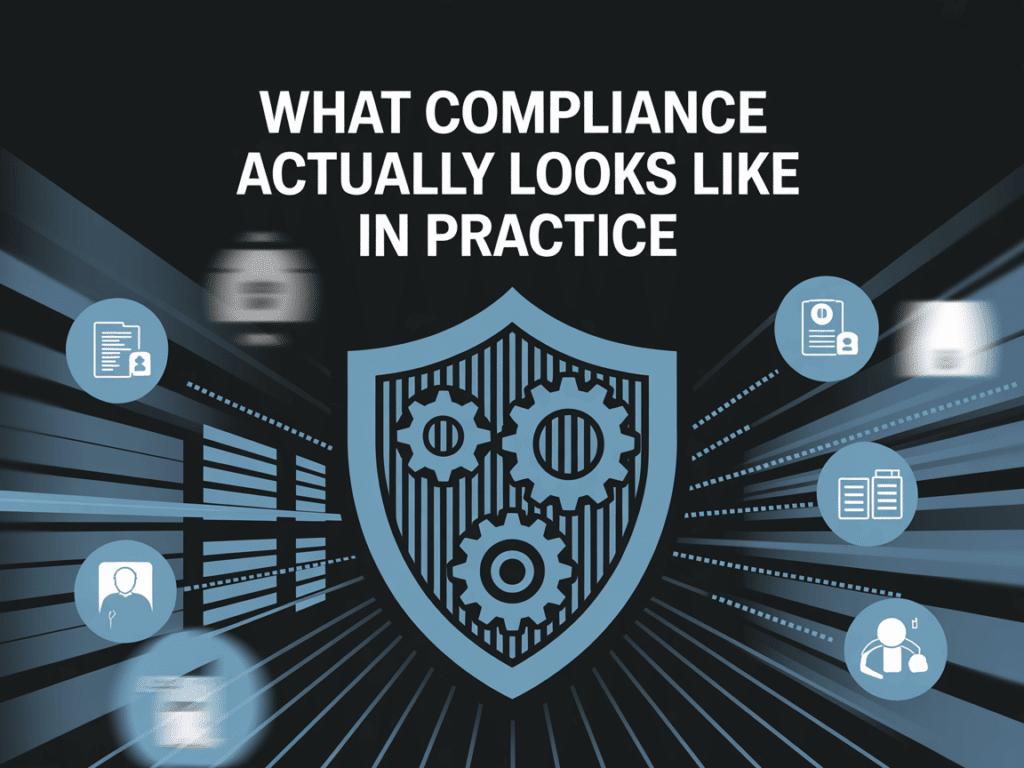Cybersecurity compliance is more than just following rules. It’s about protecting your business, your customers, and your reputation from digital threats. Every year, cyberattacks get more advanced. That’s why governments and industries around the world continue to update security standards. And if you’re running a business that collects data or operates online, you’re expected to follow these standards.
But here’s the challenge—there’s no single rulebook. Regulations vary depending on your industry, your location, and even the kind of data you collect. In this post, we’ll break down what cybersecurity compliance really means, what rules you need to know, and how to stay compliant without getting overwhelmed.
What Is Cybersecurity Compliance?
Cybersecurity compliance means meeting legal and industry requirements for how you protect your data, systems, and networks. These rules exist to make sure businesses have strong defenses against cyberattacks, data breaches, and internal risks.
For example, if you’re a healthcare company, you’re required to follow HIPAA to keep patient records safe. If you process credit card payments, you need to follow PCI DSS rules to protect cardholder data.
Most compliance rules cover four main things:
- How do you store and secure sensitive data
- Who can access that data
- How do you detect threats
- How do you respond if something goes wrong
These rules are not optional. In many industries, failing to follow them can lead to large fines, lawsuits, and a damaged reputation.
Why Cybersecurity Compliance Is Non-Negotiable Today
Security is one of the biggest challenges businesses face today. Hackers target organizations of every size, and when an attack succeeds, customer data can be stolen, trust damaged, and significant financial losses incurred.
Healthcare, financial, and educational sectors are the ones forced the most to get compliant. But now even ecommerce stores, SaaS companies, and local service providers must abide by cybersecurity rules.
That’s why many businesses are now investing in cybersecurity compliance services. These services help set policies and perform risk assessments and audit preparations. It is the assurance that everything is in line prior to the regulator’s knock.
Key Regulatory Frameworks You Need To Know
There are many compliance laws, but none really fit every situation. Below are the main frameworks depending on the location of your business as well as your industrial sector.
Global Standards
ISO/IEC 27001 – This is a well-known international standard that outlines how companies apply for information security. It portrays a system to govern risks, make policies, and improve over time.
NIST Cybersecurity Framework – Created in the U.S., it is used worldwide. It is pretty flexible and assists businesses of almost all sizes to upgrade their security practices.
These global frameworks often form the foundation of a company’s compliance program. Many businesses use them as a baseline upon which they build specific forms depending on their region or industry.
United States
HIPAA – This law protects the privacy and data of healthcare information and keeps strict limits in case your business handles such information.
PCI DSS – Any business that processes credit card payments must follow this standard to protect cardholder information.
CMMC – This must be met by a contractor-like company doing business with the Department of Defense in the U.S. It assures that contractors meet cybersecurity standards.
SOX (Sarbanes-Oxley) and GLBA – These laws apply to public companies and financial institutions, ostensibly needing strong data security, audit trails, and risk management.
Europe
GDPR – General Data Protection Regulation applies to any business in the course of collecting or processing personal data from EU citizens. It deals with data privacy and transparency.
NIS2 Directive – It extends cybersecurity requirements into other critical sectors in the EU, comprising energy, transport, and digital infrastructure.
Asia-Pacific
Countries such as Australia, Singapore, and Japan have their own distinct data privacy and cybersecurity regulations. A multinational corporation needs to have a compliance strategy adaptable to several jurisdictions.
What Compliance Actually Looks Like in Practice
Compliance is more than just writing policies. It’s about putting real protections in place.

Here’s what that usually involves:
- Creating internal security policies that match your industry’s requirements
- Setting up access controls, encryption, and backups
- Logging security events and monitoring for threats
- Training employees to spot risks like phishing attacks
- Building a response plan in case of a breach
This is where cybersecurity compliance service providers come in. They help businesses build these systems, stay updated with changing rules, and stay ready for audits.
The Role of Risk Assessment in Meeting Compliance
Almost every framework starts with one question: Where are you most at risk? That’s what a risk assessment helps you answer.
Risk assessments identify your most valuable assets and the biggest threats to those assets. From there, you can focus on protecting what matters most. For example, if you’re using cloud apps to store customer data, you might need stronger access controls and data encryption.
Frameworks like ISO 27001 and NIST require this kind of risk-based approach. It’s not just about checking boxes. It’s about making smart decisions that lower your risk in real ways.
When planning your compliance strategy, using a compliance framework gives you a structure to follow. It shows you what to do, when to do it, and how to measure progress.
Who’s Responsible for Compliance Inside a Business?
You need not be a cybersecurity expert to understand your part in compliance. Compliance is a team effort involving various departments.
IT and Security Teams
Their main duties include installing firewalls, securing systems, and monitoring concerning activities. They ensure that the technical side of compliance is being adhered to.
Compliance Officers or CISOs
These roles focus on aligning company goals with legal and regulatory requirements. They’re the ones who prepare for audits and keep everyone accountable.
Legal, HR, and Management
HR teams train staff on the security policies. The legal team ensures that contracts and data policies comply with the law. The executives provide and approve the budget for the company and dictate the security posture of the company.
This growing need for cross-functional expertise has led to more cybersecurity compliance jobs, especially in companies that handle sensitive data.
What Happens If You Fall Out of Compliance?
Failing to meet compliance standards can be serious. Take the Equifax breach as an example. It exposed personal information of over 147 million people and led to hundreds of millions in penalties.
When companies fall short, they face:
- Government fines
- Loss of customer trust
- Lawsuits
- Increased audits and restrictions
The cost of non-compliance often far outweighs the cost of investing in proper tools, training, and staff. This is why businesses now view compliance as a key part of their cybersecurity strategy, not just a side task.
Building a Sustainable Compliance Program
Strong programs are built with long-term goals in mind. That means:
- Regularly updating policies and tools
- Keeping clear documentation
- Running internal audits
- Training new employees as they join
- Adapting to new risks and regulations as they arise
Many companies use vendors like Silverfort to improve identity protection and meet compliance demands. These platforms add extra layers of access control without slowing down operations.
If you’re thinking of getting help, compliance service providers can take the pressure off your internal team. They know the frameworks. They track regulation changes. And they help you stay audit-ready.
Is Your Business Ready For Its Next Audit?
Audits don’t have to be scary. If you’ve done the work, kept your records clean, trained your staff, and followed your framework, you’ll be ready.
The key is consistency. Businesses that treat compliance like an ongoing effort (not a one-time project) tend to perform better in audits and face fewer issues.
If you’re not sure where to begin, it helps to understand the audit preparation process and the common gaps that get flagged.
Final Thoughts: Compliance as a Living Strategy
Cybersecurity compliance is not just a legal task—it’s a business strategy. It helps you stay protected, stay trusted, and stay ahead of threats. And as regulations change, your approach must grow with them.
This guide is just the start. You’ll also want to explore more topics, like what makes a strong compliance framework, how to find the right services, and how to build your team with skilled professionals in the compliance career field.
When compliance becomes part of your company culture, you don’t just avoid fines. You gain a stronger, safer business. Now’s the time to make compliance your advantage, not your afterthought. Start building a more intelligent strategy today and turn regulations into real results.

